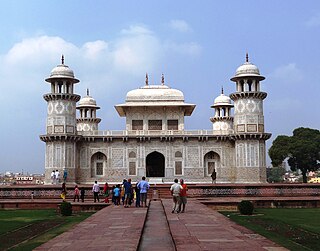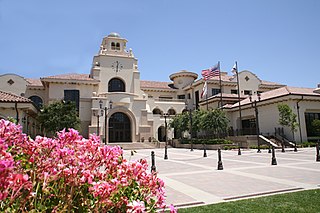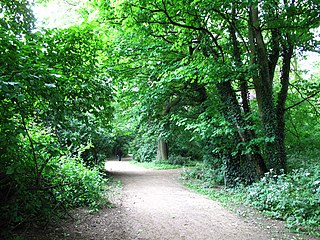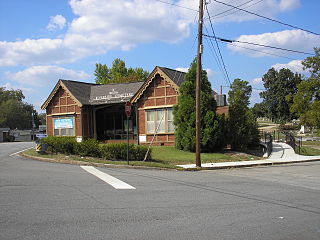This list of cemeteries in Riverside County, California includes currently operating, historical (closed for new interments), and defunct (graves abandoned or removed) cemeteries, columbaria, and mausolea in Riverside County, California. It does not include pet cemeteries. Selected interments are given for notable people.

A tomb or sepulcher is a repository for the remains of the dead. It is generally any structurally enclosed interment space or burial chamber, of varying sizes. Placing a corpse into a tomb can be called immurement, although this word mainly means entombing people alive, and is a method of final disposition, as an alternative to cremation or burial.

Arlington National Cemetery is one of two cemeteries in the United States National Cemetery System that are maintained by the United States Army. Nearly 400,000 people are buried in its 639 acres in Arlington County, Virginia.

Temecula is a city in southwestern Riverside County, California, United States. The city had a population of 110,003 as of the 2020 census and was incorporated on December 1, 1989. The city is a tourist and resort destination, with the Temecula Valley Wine Country, Old Town Temecula, the Temecula Valley Balloon & Wine Festival, the Temecula Valley International Film Festival, championship golf courses, and resort accommodations contributing to the city's economic profile.

Wildomar is a city in southwest Riverside County, California, United States. The city was incorporated on July 1, 2008. As of the 2020 census, the population was 36,875. The community has grown very quickly during the early twenty-first century; the population has more than doubled since the 2000 census, when the community was still an unincorporated census-designated place.

Natural burial is the interment of the body of a dead person in the soil in a manner that does not inhibit decomposition but allows the body to be naturally recycled. It is an alternative to typical contemporary Western burial methods and modern funerary customs.
The Temecula massacre took place in December 1846 east of present-day Temecula, California, United States. It was part of a series of related events in the Mexican–American War. A combined force of Californio militia and Cahuilla Indians attacked and killed an estimated 33 to 40 Luiseño Indians. The Mexican authorities in California took the military action in retaliation for the Indians' killing 11 Californio lancers, in what was called the Pauma Massacre.
Temecula Creek, formerly known as the Temecula River, runs 32.6 miles (52.5 km) through southern Riverside County, California, United States, past the rural communities of Radec and Aguanga, and ending 0.5 miles (0.80 km) southeast of the original city center of Temecula. The creek is filled with boulders and is typically dry and sandy. It is a relatively undeveloped coastal-draining watershed. Until the 1920s, water flowed in Temecula Creek year-round.
Rancho Little Temecula was a 2,233-acre (9.04 km2) Mexican land grant in present-day Riverside County, California given in 1845 by Governor Pío Pico to Pablo Apis. The grant was one of the few held by indigenous people. The grant is south of present-day Temecula and is bordered on the north by Temecula Creek. At the time of the US patent, Rancho Little Temecula was a part of San Diego County. Riverside County was created by the California Legislature in 1893 by taking land from both San Bernardino and San Diego Counties.

Desert Memorial Park is a cemetery in Cathedral City, California, United States, near Palm Springs. Opening in 1956 and receiving its first interment in 1957, it is maintained by the Palm Springs Cemetery District. The District also maintains the Welwood Murray Cemetery in Palm Springs.

Riverside County is a county located in the southern portion of the U.S. state of California. As of the 2020 census, the population was 2,418,185, making it the fourth-most populous county in California and the 10th-most populous in the United States. The name was derived from the city of Riverside, which is the county seat.

Agua Mansa is a former settlement in an unincorporated area of San Bernardino County, near Colton, California, United States. Once the largest settlement in San Bernardino County, it is now a ghost town. Only the cemetery remains.
Radec is a small unincorporated community in Riverside County, California, United States. Located roughly 15 miles east by southeast of the city of Temecula, the community of Radec is located along Highway 79. Having bought land in the area in 1883, early settler Samuel Tripp set up a post office there. As of 1893–4, a local directory listed the area as growing honey, hay and stock, but also as having "no commercial interest of any kind." A total of 14 people, mainly farmers and beekeepers, plus a laborer and Tripp, are listed in the directory. The County of Riverside owns a small, non-operational cemetery in Radec.

Hull General Cemetery was established by a private company in 1847 on Spring Bank in the west of Kingston upon Hull, East Riding of Yorkshire, England. In 1862 the Hull Corporation established a cemetery adjacent, now known as Western Cemetery, and in c. 1890 expanded the cemetery west across Chanterlands Avenue onto an adjacent site.

Riverside Cemetery is a historic rural cemetery in Macon, Georgia established in 1887. It is approximately 54 acres (22 ha) in size and privately owned. Over 18,000 people are interred here.